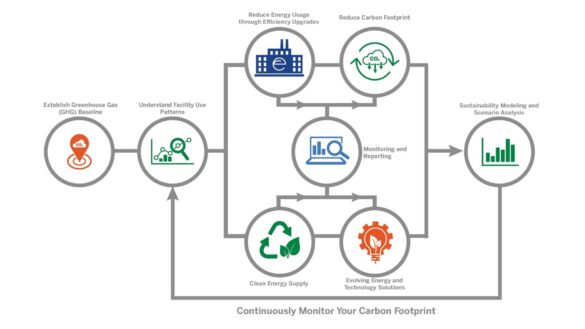Establishing your GHG Emissions Baseline
Energy sustainability is no longer a lofty buzzword, but is in fact, an increasingly important factor in achieving long-term success. Even if your organization has set goals, designing and executing a robust sustainability plan can be complicated. Building an effective plan requires consideration for evolving technology and clean energy supply options. It requires balancing investment in the future while keeping tight to the budget now. These challenges make it clear: reducing emissions requires more than the right mindset. It requires a sustainability roadmap that clearly and transparently lays out how to properly execute and meet your objectives. In this blog series, Constellation will help guide you through the various steps to developing effective sustainability strategies.

As organizations strive to embrace a more sustainable future, establishing a greenhouse gas (GHG) emissions baseline is a crucial starting point. Greenhouse gases are emitted by many sources and are classified as either Scope 1, 2, or 3 emissions. Scope 1 emissions are the direct emissions from an entity’s operations while Scope 2 emissions are the indirect emissions from an entity’s purchased utilities. Multiple solutions exist to help reduce Scope 1 and 2 emissions. Scope 3 emissions occur in the value chain of an entity, such as upstream emissions from suppliers, downstream emissions from customers using their products, or emissions associated with the business travel or commuting of an entity’s employees. Scope 3 is quickly gaining more attention as many companies look for even more leadership opportunities in the climate space by setting targets on their value chain emissions. A GHG emissions baseline serves as a foundation for understanding an organization’s current emissions profile that can lead to enabling informed decision-making, target setting, and effective implementation of emissions reduction strategies.
According to a 2022 ESG Global Study, companies that demonstrate progress toward environmental sustainability, like clearly reporting their GHG emissions, have found more success than they might have if they had not seen progress: some 87% of consumers want to spend more with them and 83% of potential investors want to back them financially. Transparent reporting attracts and retains workforce talent, too. 83% of employees surveyed shared that they want to work for employers and brands that take environmental and social issues seriously.1
To begin, a business or organization can depend on several areas of guidance and methodologies to help them define appropriate GHG reduction targets.
Self-Defined GHG Emissions Targets
Many organizations have set self-defined GHG emissions targets, such as Constellation’s own climate commitments. These goals typically focus on reducing emissions by a certain percentage from their baseline emissions by a specific deadline. For example, a company might set an absolute target to reduce 50% of their 2020 emissions by 2050. Without first gathering the data and calculating the 2020 emissions baseline, it is impossible to quantify progress or measure success. It is also common for organizations to set multiple goals, milestones, or intensity targets where they might track emissions against a different benchmark such as headcount or production (for example, metric tons emitted per widget produced).
Self-defined GHG targets may be established for various reasons, such as corporate social responsibility, environmental sustainability goals, or to demonstrate leadership in addressing climate change. These targets are completely voluntary and allow organizations to demonstrate their commitment to a sustainable future.
Federal, State or Local Requirements
While an increasing number of organizations have voluntarily been working towards self-defined GHG targets, certain federal, state and local laws are being introduced that require organizations to report GHG emissions or achieve certain reductions. The United States Federal Government requires entities with sources that emit at least 25,000 metric tons of carbon dioxide equivalent to report resulting GHG emissions for those facilities to the Environmental Protection Agency (EPA) annually.2
Additionally, 24 states plus the District of Columbia have adopted specific GHG reduction targets to address climate change3. Even specific cities such as New York City, Washington D.C., Chicago and Philadelphia, require businesses to track their energy consumption and some also require yearly reports. To learn about your state’s requirements, visit: https://www.c2es.org/content/state-climate-policy/
Science Based Targets
The science-based target approach provides a framework for setting GHG reduction goals and avoiding the most severe impacts of climate change. Reduction efforts follow the latest climate science and the objective of limiting global warming to well below 1.5degrees Celsius above pre-industrial levels, as outlined in the Paris Agreement5. These targets are typically developed using scientific models and scenarios that project the level of emissions reductions necessary to achieve specific temperature goals.
To learn more about sector-specific goals or how your organization can begin to set science-based emissions reduction targets, visit: https://sciencebasedtargets.org.
Take Action Today
Working with a trusted energy expert like Constellation can help your organization establish actionable and attainable GHG benchmarks for meaningful sustainability initiatives and positions you as a responsible and forward-thinking leader in addressing the pressing challenges of the climate.
Learn more about building your sustainability roadmap with our new white paper
1: https://www.oracle.com/a/ocom/docs/applications/esg-study-no-planet-b-report.pdf
2: https://www.epa.gov/sites/default/files/2014-09/documents/ghgrp-overview-factsheet.pdf
3: https://www.oracle.com/a/ocom/docs/applications/esg-study-no-planet-b-report.pdf
4: https://www.govinfo.gov/content/pkg/FR-2022-04-11/pdf/2022-06342.pdf
5: https://sciencebasedtargets.org/news/sbti-raises-the-bar-to-1-5-c

